Accounting for Business: Financial Ratios and Investment Decisions
VerifiedAdded on 2023/06/14
|12
|1944
|378
Homework Assignment
AI Summary
This document presents a comprehensive solution to an accounting for business exam, covering key areas such as financial statement analysis and investment appraisal. The solution includes the preparation of an income statement and balance sheet, along with calculations and interpretations of financial ratios like gross profit ratio, net profit ratio, current ratio, and quick ratio for two companies. Furthermore, the document evaluates investment opportunities using payback period, net present value (NPV), and internal rate of return (IRR) methods, discussing the qualitative factors influencing investment decisions. This resource is ideal for students seeking to understand and master fundamental concepts in accounting and finance, with Desklib providing additional study tools and solved assignments.
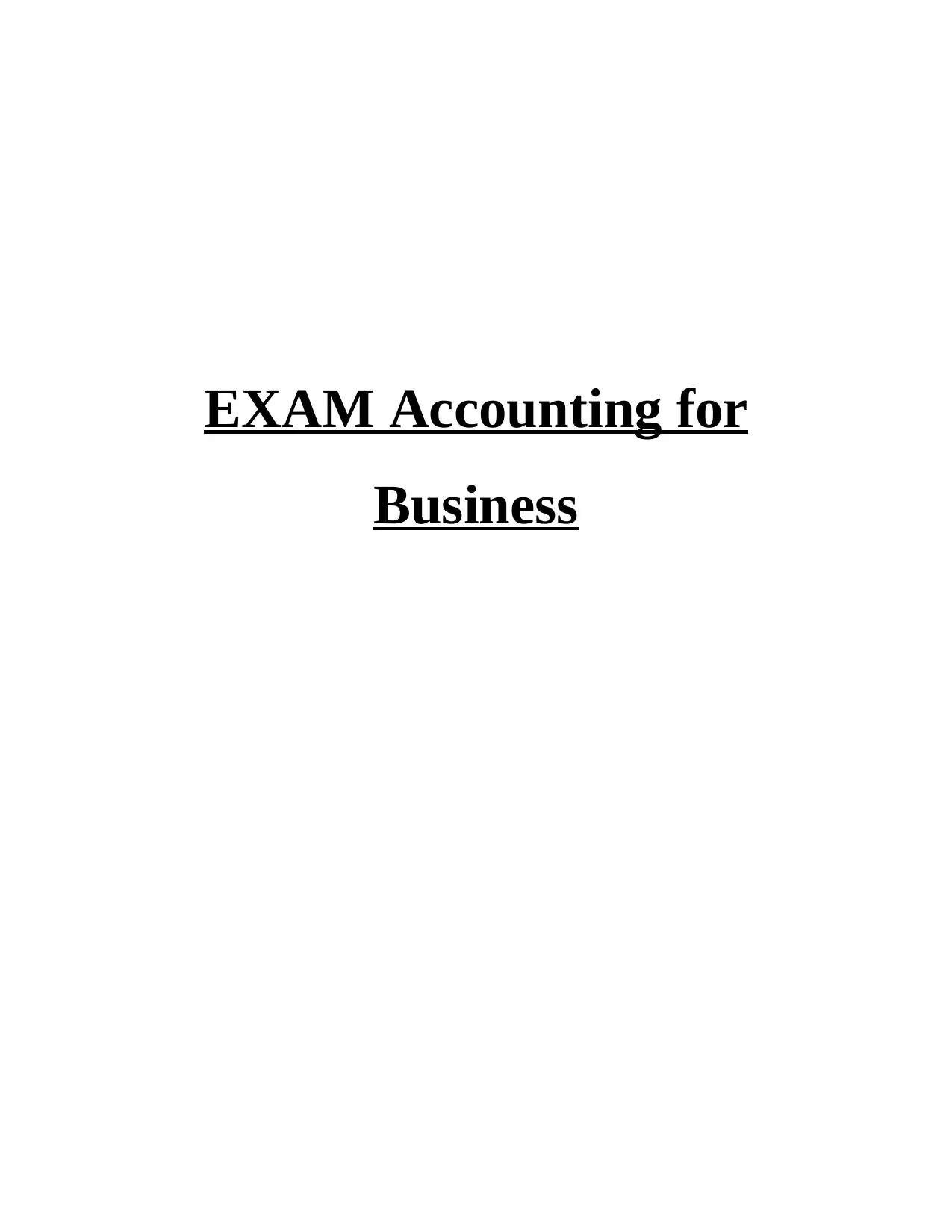
EXAM Accounting for
Business
Business
Paraphrase This Document
Need a fresh take? Get an instant paraphrase of this document with our AI Paraphraser
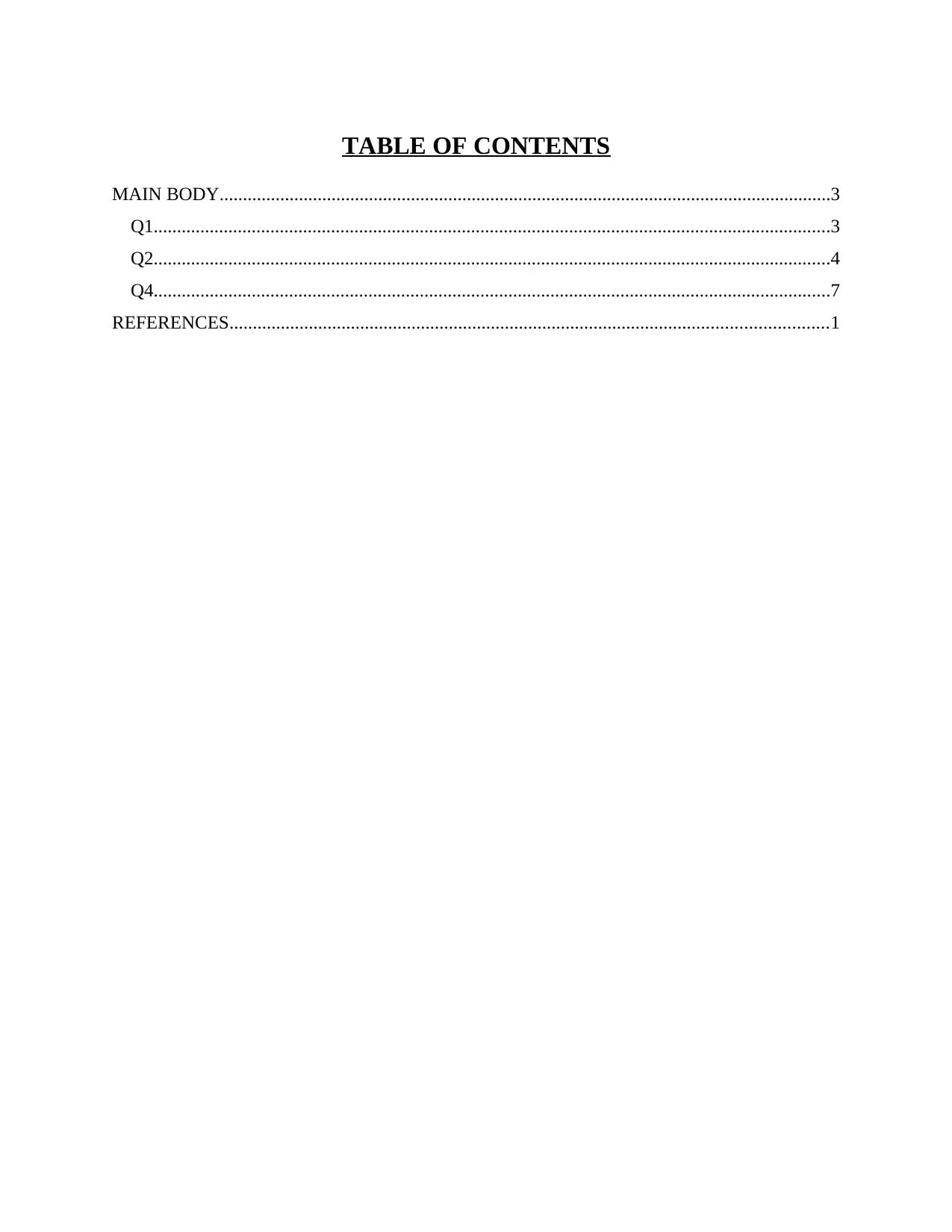
TABLE OF CONTENTS
MAIN BODY...................................................................................................................................3
Q1.................................................................................................................................................3
Q2.................................................................................................................................................4
Q4.................................................................................................................................................7
REFERENCES................................................................................................................................1
MAIN BODY...................................................................................................................................3
Q1.................................................................................................................................................3
Q2.................................................................................................................................................4
Q4.................................................................................................................................................7
REFERENCES................................................................................................................................1
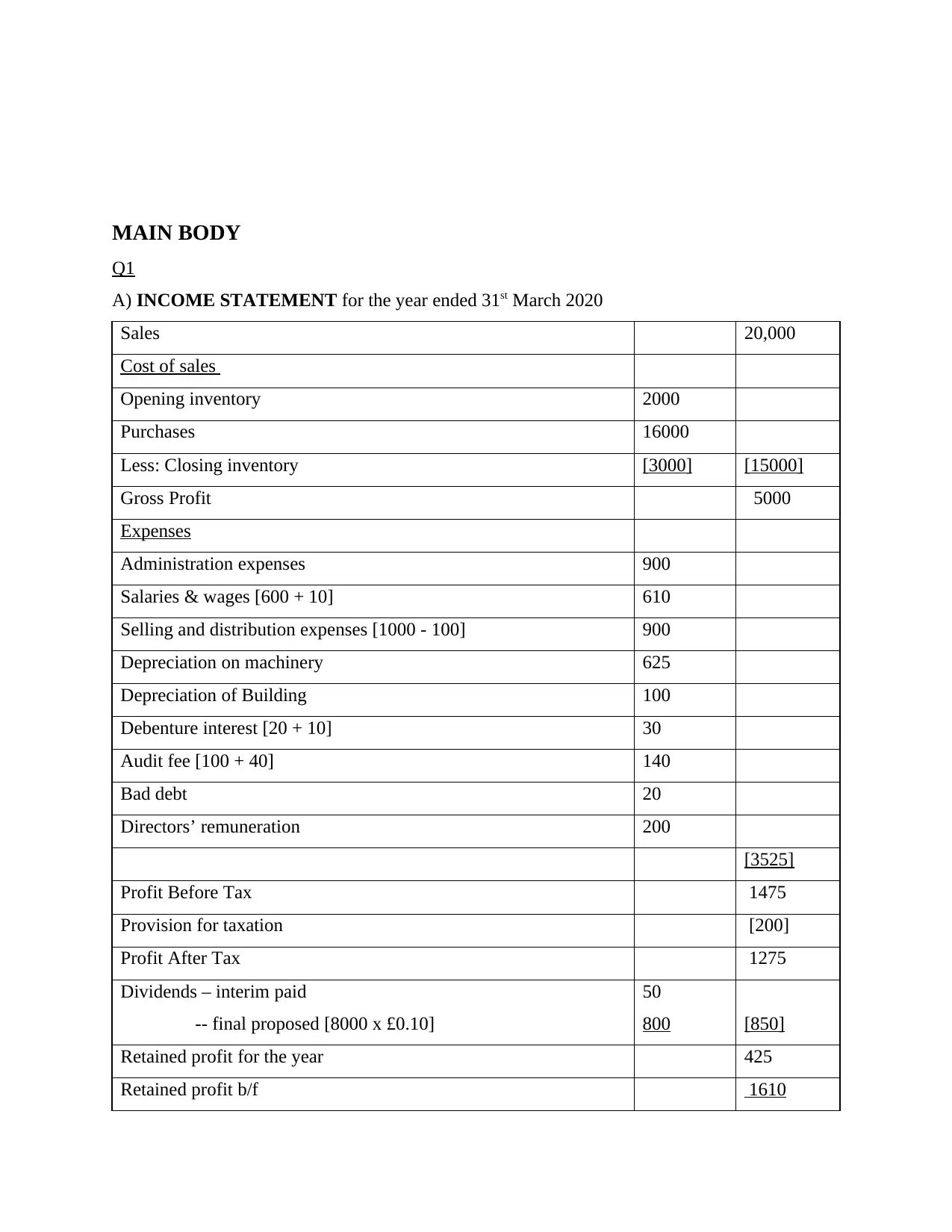
MAIN BODY
Q1
A) INCOME STATEMENT for the year ended 31st March 2020
Sales 20,000
Cost of sales
Opening inventory 2000
Purchases 16000
Less: Closing inventory [3000] [15000]
Gross Profit 5000
Expenses
Administration expenses 900
Salaries & wages [600 + 10] 610
Selling and distribution expenses [1000 - 100] 900
Depreciation on machinery 625
Depreciation of Building 100
Debenture interest [20 + 10] 30
Audit fee [100 + 40] 140
Bad debt 20
Directors’ remuneration 200
[3525]
Profit Before Tax 1475
Provision for taxation [200]
Profit After Tax 1275
Dividends – interim paid
-- final proposed [8000 x £0.10]
50
800 [850]
Retained profit for the year 425
Retained profit b/f 1610
Q1
A) INCOME STATEMENT for the year ended 31st March 2020
Sales 20,000
Cost of sales
Opening inventory 2000
Purchases 16000
Less: Closing inventory [3000] [15000]
Gross Profit 5000
Expenses
Administration expenses 900
Salaries & wages [600 + 10] 610
Selling and distribution expenses [1000 - 100] 900
Depreciation on machinery 625
Depreciation of Building 100
Debenture interest [20 + 10] 30
Audit fee [100 + 40] 140
Bad debt 20
Directors’ remuneration 200
[3525]
Profit Before Tax 1475
Provision for taxation [200]
Profit After Tax 1275
Dividends – interim paid
-- final proposed [8000 x £0.10]
50
800 [850]
Retained profit for the year 425
Retained profit b/f 1610
⊘ This is a preview!⊘
Do you want full access?
Subscribe today to unlock all pages.

Trusted by 1+ million students worldwide
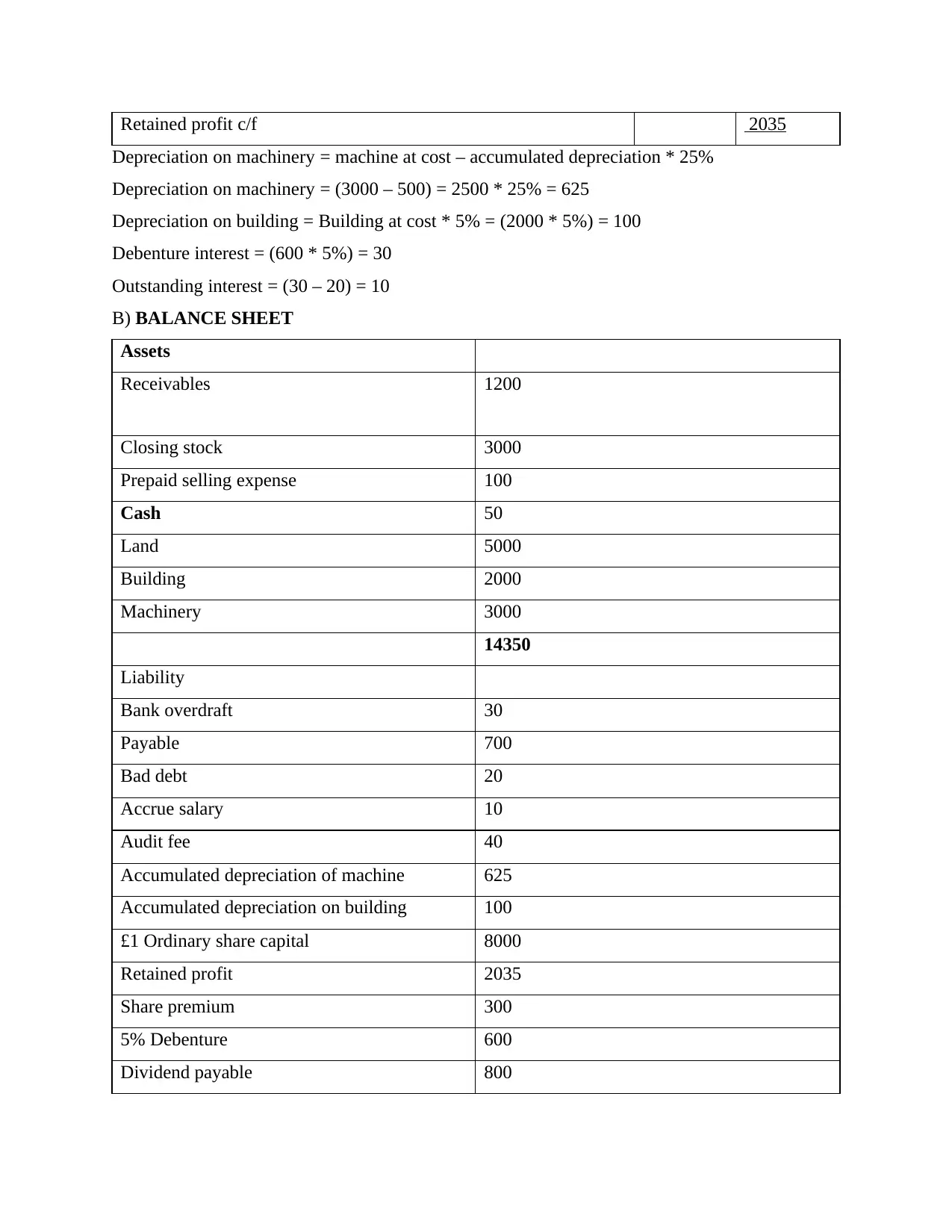
Retained profit c/f 2035
Depreciation on machinery = machine at cost – accumulated depreciation * 25%
Depreciation on machinery = (3000 – 500) = 2500 * 25% = 625
Depreciation on building = Building at cost * 5% = (2000 * 5%) = 100
Debenture interest = (600 * 5%) = 30
Outstanding interest = (30 – 20) = 10
B) BALANCE SHEET
Assets
Receivables 1200
Closing stock 3000
Prepaid selling expense 100
Cash 50
Land 5000
Building 2000
Machinery 3000
14350
Liability
Bank overdraft 30
Payable 700
Bad debt 20
Accrue salary 10
Audit fee 40
Accumulated depreciation of machine 625
Accumulated depreciation on building 100
£1 Ordinary share capital 8000
Retained profit 2035
Share premium 300
5% Debenture 600
Dividend payable 800
Depreciation on machinery = machine at cost – accumulated depreciation * 25%
Depreciation on machinery = (3000 – 500) = 2500 * 25% = 625
Depreciation on building = Building at cost * 5% = (2000 * 5%) = 100
Debenture interest = (600 * 5%) = 30
Outstanding interest = (30 – 20) = 10
B) BALANCE SHEET
Assets
Receivables 1200
Closing stock 3000
Prepaid selling expense 100
Cash 50
Land 5000
Building 2000
Machinery 3000
14350
Liability
Bank overdraft 30
Payable 700
Bad debt 20
Accrue salary 10
Audit fee 40
Accumulated depreciation of machine 625
Accumulated depreciation on building 100
£1 Ordinary share capital 8000
Retained profit 2035
Share premium 300
5% Debenture 600
Dividend payable 800
Paraphrase This Document
Need a fresh take? Get an instant paraphrase of this document with our AI Paraphraser
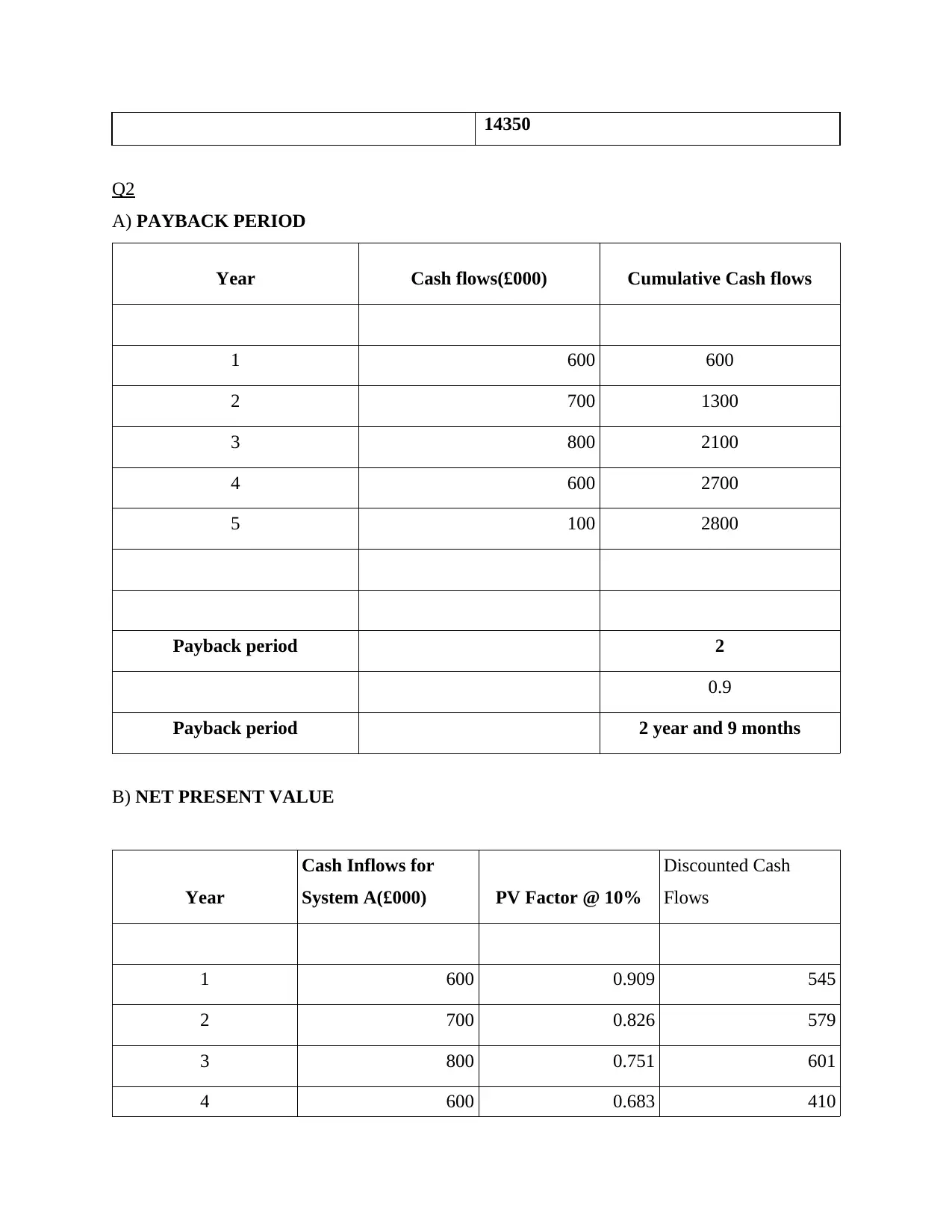
14350
Q2
A) PAYBACK PERIOD
Year Cash flows(£000) Cumulative Cash flows
1 600 600
2 700 1300
3 800 2100
4 600 2700
5 100 2800
Payback period 2
0.9
Payback period 2 year and 9 months
B) NET PRESENT VALUE
Year
Cash Inflows for
System A(£000) PV Factor @ 10%
Discounted Cash
Flows
1 600 0.909 545
2 700 0.826 579
3 800 0.751 601
4 600 0.683 410
Q2
A) PAYBACK PERIOD
Year Cash flows(£000) Cumulative Cash flows
1 600 600
2 700 1300
3 800 2100
4 600 2700
5 100 2800
Payback period 2
0.9
Payback period 2 year and 9 months
B) NET PRESENT VALUE
Year
Cash Inflows for
System A(£000) PV Factor @ 10%
Discounted Cash
Flows
1 600 0.909 545
2 700 0.826 579
3 800 0.751 601
4 600 0.683 410
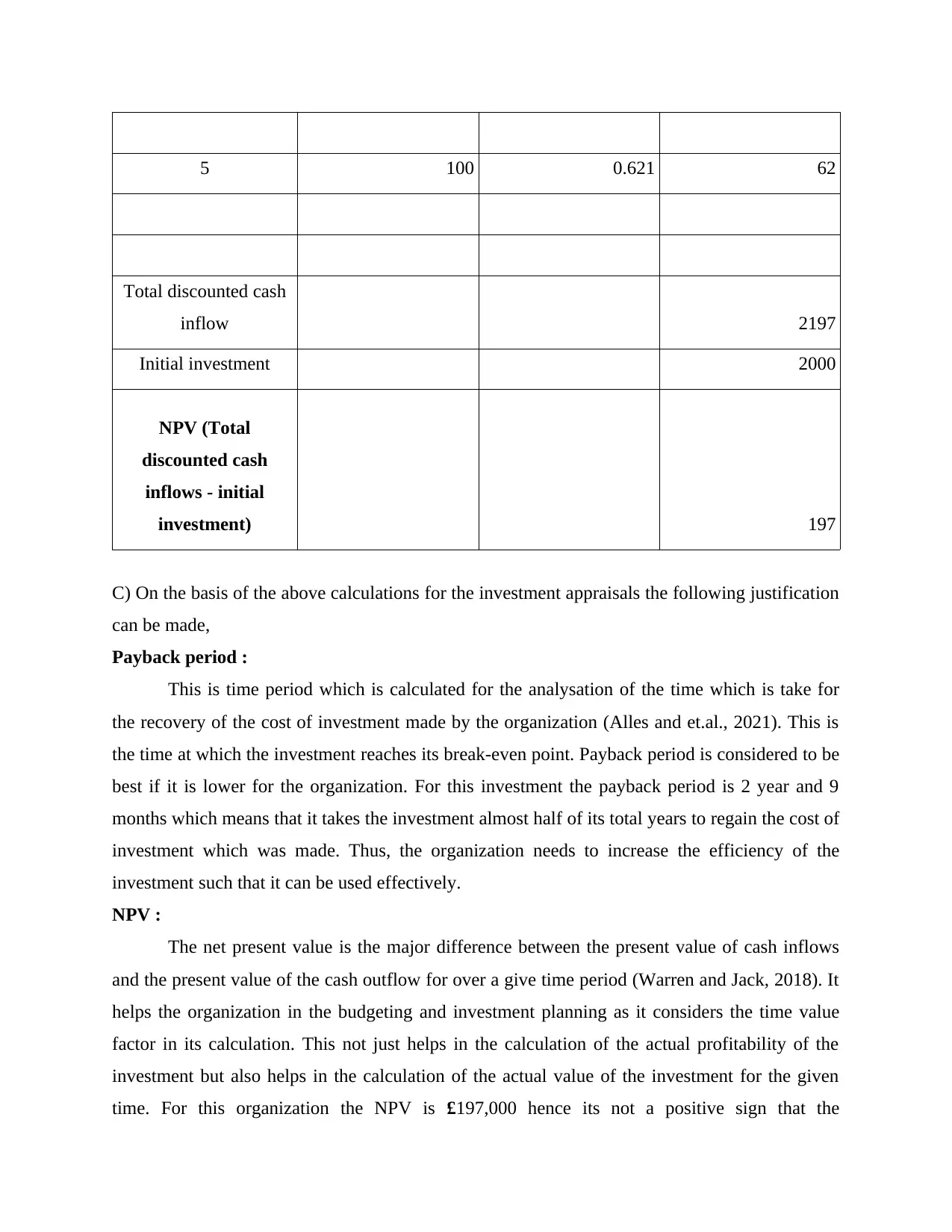
5 100 0.621 62
Total discounted cash
inflow 2197
Initial investment 2000
NPV (Total
discounted cash
inflows - initial
investment) 197
C) On the basis of the above calculations for the investment appraisals the following justification
can be made,
Payback period :
This is time period which is calculated for the analysation of the time which is take for
the recovery of the cost of investment made by the organization (Alles and et.al., 2021). This is
the time at which the investment reaches its break-even point. Payback period is considered to be
best if it is lower for the organization. For this investment the payback period is 2 year and 9
months which means that it takes the investment almost half of its total years to regain the cost of
investment which was made. Thus, the organization needs to increase the efficiency of the
investment such that it can be used effectively.
NPV :
The net present value is the major difference between the present value of cash inflows
and the present value of the cash outflow for over a give time period (Warren and Jack, 2018). It
helps the organization in the budgeting and investment planning as it considers the time value
factor in its calculation. This not just helps in the calculation of the actual profitability of the
investment but also helps in the calculation of the actual value of the investment for the given
time. For this organization the NPV is £197,000 hence its not a positive sign that the
Total discounted cash
inflow 2197
Initial investment 2000
NPV (Total
discounted cash
inflows - initial
investment) 197
C) On the basis of the above calculations for the investment appraisals the following justification
can be made,
Payback period :
This is time period which is calculated for the analysation of the time which is take for
the recovery of the cost of investment made by the organization (Alles and et.al., 2021). This is
the time at which the investment reaches its break-even point. Payback period is considered to be
best if it is lower for the organization. For this investment the payback period is 2 year and 9
months which means that it takes the investment almost half of its total years to regain the cost of
investment which was made. Thus, the organization needs to increase the efficiency of the
investment such that it can be used effectively.
NPV :
The net present value is the major difference between the present value of cash inflows
and the present value of the cash outflow for over a give time period (Warren and Jack, 2018). It
helps the organization in the budgeting and investment planning as it considers the time value
factor in its calculation. This not just helps in the calculation of the actual profitability of the
investment but also helps in the calculation of the actual value of the investment for the given
time. For this organization the NPV is £197,000 hence its not a positive sign that the
⊘ This is a preview!⊘
Do you want full access?
Subscribe today to unlock all pages.

Trusted by 1+ million students worldwide
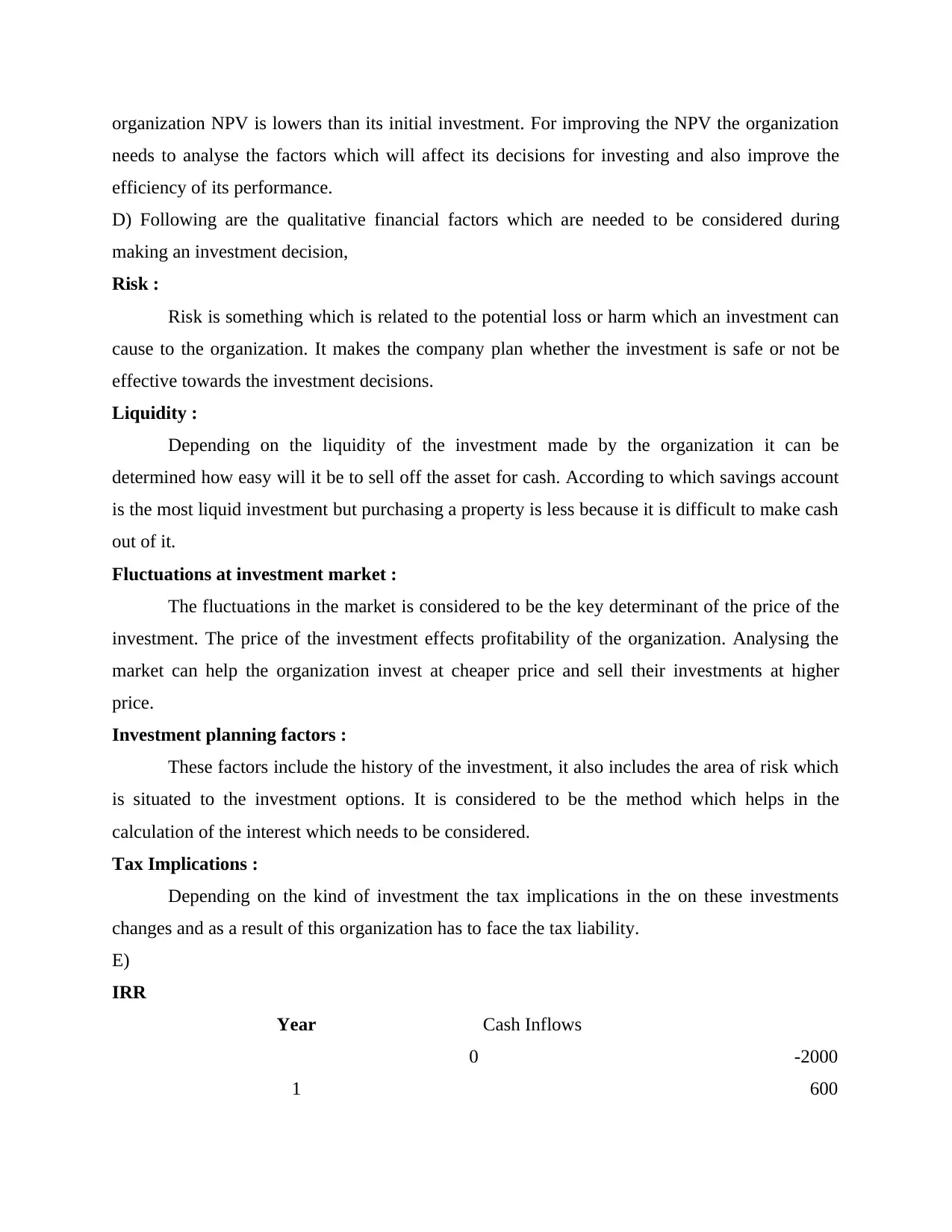
organization NPV is lowers than its initial investment. For improving the NPV the organization
needs to analyse the factors which will affect its decisions for investing and also improve the
efficiency of its performance.
D) Following are the qualitative financial factors which are needed to be considered during
making an investment decision,
Risk :
Risk is something which is related to the potential loss or harm which an investment can
cause to the organization. It makes the company plan whether the investment is safe or not be
effective towards the investment decisions.
Liquidity :
Depending on the liquidity of the investment made by the organization it can be
determined how easy will it be to sell off the asset for cash. According to which savings account
is the most liquid investment but purchasing a property is less because it is difficult to make cash
out of it.
Fluctuations at investment market :
The fluctuations in the market is considered to be the key determinant of the price of the
investment. The price of the investment effects profitability of the organization. Analysing the
market can help the organization invest at cheaper price and sell their investments at higher
price.
Investment planning factors :
These factors include the history of the investment, it also includes the area of risk which
is situated to the investment options. It is considered to be the method which helps in the
calculation of the interest which needs to be considered.
Tax Implications :
Depending on the kind of investment the tax implications in the on these investments
changes and as a result of this organization has to face the tax liability.
E)
IRR
Year Cash Inflows
0 -2000
1 600
needs to analyse the factors which will affect its decisions for investing and also improve the
efficiency of its performance.
D) Following are the qualitative financial factors which are needed to be considered during
making an investment decision,
Risk :
Risk is something which is related to the potential loss or harm which an investment can
cause to the organization. It makes the company plan whether the investment is safe or not be
effective towards the investment decisions.
Liquidity :
Depending on the liquidity of the investment made by the organization it can be
determined how easy will it be to sell off the asset for cash. According to which savings account
is the most liquid investment but purchasing a property is less because it is difficult to make cash
out of it.
Fluctuations at investment market :
The fluctuations in the market is considered to be the key determinant of the price of the
investment. The price of the investment effects profitability of the organization. Analysing the
market can help the organization invest at cheaper price and sell their investments at higher
price.
Investment planning factors :
These factors include the history of the investment, it also includes the area of risk which
is situated to the investment options. It is considered to be the method which helps in the
calculation of the interest which needs to be considered.
Tax Implications :
Depending on the kind of investment the tax implications in the on these investments
changes and as a result of this organization has to face the tax liability.
E)
IRR
Year Cash Inflows
0 -2000
1 600
Paraphrase This Document
Need a fresh take? Get an instant paraphrase of this document with our AI Paraphraser

2 700
3 800
4 600
5 100
6
IRR 14%
Internal rate of return is a metric which is used for the estimation of the profitability of
the potential investments (Al-Mutairi, Naser and Saeid, 2018). IRR is the discounted rate which
makes the net present value of all cash flow equal to zero thus, the discounted cash flow analysis
is done in IRR. It is said to be the actual percentage of annual return if the investments NPV was
0. IRR shows the annualized rate of return for a give investment it can be calculated for any time
limited and with a give expected cash flow. It is essential for the IRR to be higher as it shows
that the investment is going to be more desirable for the company. In this calculation the IRR is
14% which is very average. Thus, it is very important for the organization to focus on how to
improve the effectiveness of there performance through this investment.
Q4
A) Calculation of financial ratios for A LTD and B LTD
Gross profit Ratio
Particular Formula A ltd B ltd
gross profit ratio gross profit/ sales * 100 35.00 33.33
gross profit 350 200
sales 1000 600
Net profit ratio
Particular Formula A ltd B ltd
net profit ratio net profit/ sales * 100 19.00 19.17
net profit 190 115
sales 1000 600
3 800
4 600
5 100
6
IRR 14%
Internal rate of return is a metric which is used for the estimation of the profitability of
the potential investments (Al-Mutairi, Naser and Saeid, 2018). IRR is the discounted rate which
makes the net present value of all cash flow equal to zero thus, the discounted cash flow analysis
is done in IRR. It is said to be the actual percentage of annual return if the investments NPV was
0. IRR shows the annualized rate of return for a give investment it can be calculated for any time
limited and with a give expected cash flow. It is essential for the IRR to be higher as it shows
that the investment is going to be more desirable for the company. In this calculation the IRR is
14% which is very average. Thus, it is very important for the organization to focus on how to
improve the effectiveness of there performance through this investment.
Q4
A) Calculation of financial ratios for A LTD and B LTD
Gross profit Ratio
Particular Formula A ltd B ltd
gross profit ratio gross profit/ sales * 100 35.00 33.33
gross profit 350 200
sales 1000 600
Net profit ratio
Particular Formula A ltd B ltd
net profit ratio net profit/ sales * 100 19.00 19.17
net profit 190 115
sales 1000 600
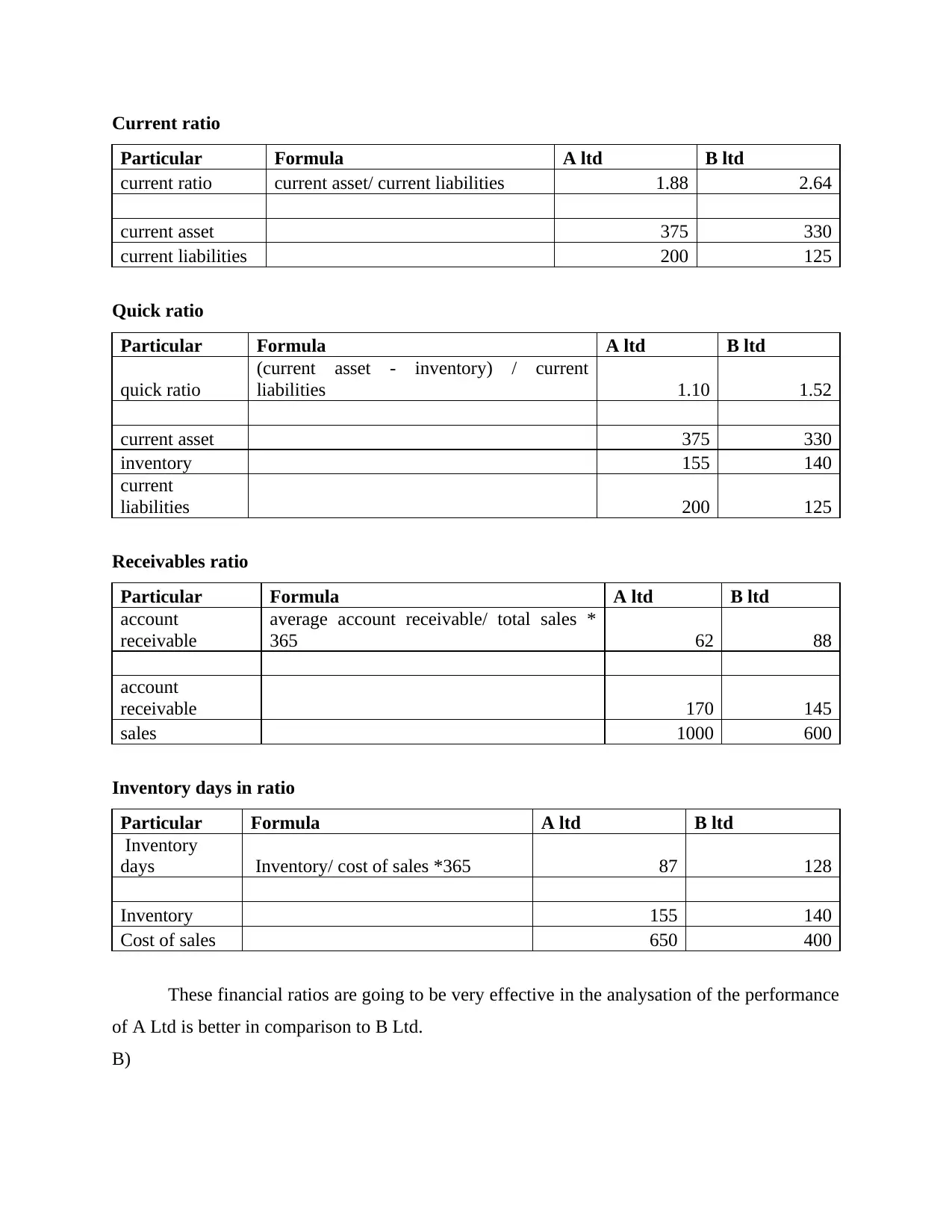
Current ratio
Particular Formula A ltd B ltd
current ratio current asset/ current liabilities 1.88 2.64
current asset 375 330
current liabilities 200 125
Quick ratio
Particular Formula A ltd B ltd
quick ratio
(current asset - inventory) / current
liabilities 1.10 1.52
current asset 375 330
inventory 155 140
current
liabilities 200 125
Receivables ratio
Particular Formula A ltd B ltd
account
receivable
average account receivable/ total sales *
365 62 88
account
receivable 170 145
sales 1000 600
Inventory days in ratio
Particular Formula A ltd B ltd
Inventory
days Inventory/ cost of sales *365 87 128
Inventory 155 140
Cost of sales 650 400
These financial ratios are going to be very effective in the analysation of the performance
of A Ltd is better in comparison to B Ltd.
B)
Particular Formula A ltd B ltd
current ratio current asset/ current liabilities 1.88 2.64
current asset 375 330
current liabilities 200 125
Quick ratio
Particular Formula A ltd B ltd
quick ratio
(current asset - inventory) / current
liabilities 1.10 1.52
current asset 375 330
inventory 155 140
current
liabilities 200 125
Receivables ratio
Particular Formula A ltd B ltd
account
receivable
average account receivable/ total sales *
365 62 88
account
receivable 170 145
sales 1000 600
Inventory days in ratio
Particular Formula A ltd B ltd
Inventory
days Inventory/ cost of sales *365 87 128
Inventory 155 140
Cost of sales 650 400
These financial ratios are going to be very effective in the analysation of the performance
of A Ltd is better in comparison to B Ltd.
B)
⊘ This is a preview!⊘
Do you want full access?
Subscribe today to unlock all pages.

Trusted by 1+ million students worldwide

The financial comparison between A Ltd and B Ltd can be done through the comparison
of their financial ratios,
GP ratio :
This is the ratio which measures the performance of the business efficiency as it is the
division of gross profit by the total sales (Ding, Peng and Wang, 2019). For A Ltd the gross
profit ratio is 35% which is higher than that of B Ltd showing that the A Ltd is more efficient in
between them.
NP ratio :
It is very similar to GP ratio but in this ratio the taxes which the business incurs is also
deducted from the gross profit for the calculation of the Net profit. Thus, NP ratio just like GP
ratio indicates the same operational soundness of the business. A Ltd has lower NP ratio at 19%
whereas B Ltd has 19.17%. It basically shows that A Ltd has more tax liability in comparison to
B Ltd.
Current Ratio :
This is the ratio which shows the liquidity of the organization, it is directly associated
with the efficiency of the organization (Correa-Mejía and Lopera-Castaño, 2020). A Ltd has
lower current ratio at 1.88 and B Ltd has 2.64 which means that B Ltd is more liquid and has
more than idea current ratio.
Quick Ratio :
This ratio shows the capacity of an organization to pay of its current liabilities without
needing to sell its inventory. In this ratio A Ltd again fall behind B Ltd as it has 1.52 whereas A
Ltd is at 1.10.
Receivables ratio :
This ratio is the accounting measurement which is used for the quantified measurement
of the organizations effectiveness and also help it to collect the accounts receivables (Morales-
Díaz and Zamora-Ramírez, 2018). The lowers the receivable ratio is for an organization it makes
it perform better. A Ltd outshines B Ltd as it has lower receivable ratio out of the two.
Inventory Days in ratio :
This ratio is in days in which the amount of time that is taken for the inventory to get
completely sold is calculated. Lower inventory days period shows higher efficiency in the
management which is present for A Ltd.
of their financial ratios,
GP ratio :
This is the ratio which measures the performance of the business efficiency as it is the
division of gross profit by the total sales (Ding, Peng and Wang, 2019). For A Ltd the gross
profit ratio is 35% which is higher than that of B Ltd showing that the A Ltd is more efficient in
between them.
NP ratio :
It is very similar to GP ratio but in this ratio the taxes which the business incurs is also
deducted from the gross profit for the calculation of the Net profit. Thus, NP ratio just like GP
ratio indicates the same operational soundness of the business. A Ltd has lower NP ratio at 19%
whereas B Ltd has 19.17%. It basically shows that A Ltd has more tax liability in comparison to
B Ltd.
Current Ratio :
This is the ratio which shows the liquidity of the organization, it is directly associated
with the efficiency of the organization (Correa-Mejía and Lopera-Castaño, 2020). A Ltd has
lower current ratio at 1.88 and B Ltd has 2.64 which means that B Ltd is more liquid and has
more than idea current ratio.
Quick Ratio :
This ratio shows the capacity of an organization to pay of its current liabilities without
needing to sell its inventory. In this ratio A Ltd again fall behind B Ltd as it has 1.52 whereas A
Ltd is at 1.10.
Receivables ratio :
This ratio is the accounting measurement which is used for the quantified measurement
of the organizations effectiveness and also help it to collect the accounts receivables (Morales-
Díaz and Zamora-Ramírez, 2018). The lowers the receivable ratio is for an organization it makes
it perform better. A Ltd outshines B Ltd as it has lower receivable ratio out of the two.
Inventory Days in ratio :
This ratio is in days in which the amount of time that is taken for the inventory to get
completely sold is calculated. Lower inventory days period shows higher efficiency in the
management which is present for A Ltd.
Paraphrase This Document
Need a fresh take? Get an instant paraphrase of this document with our AI Paraphraser

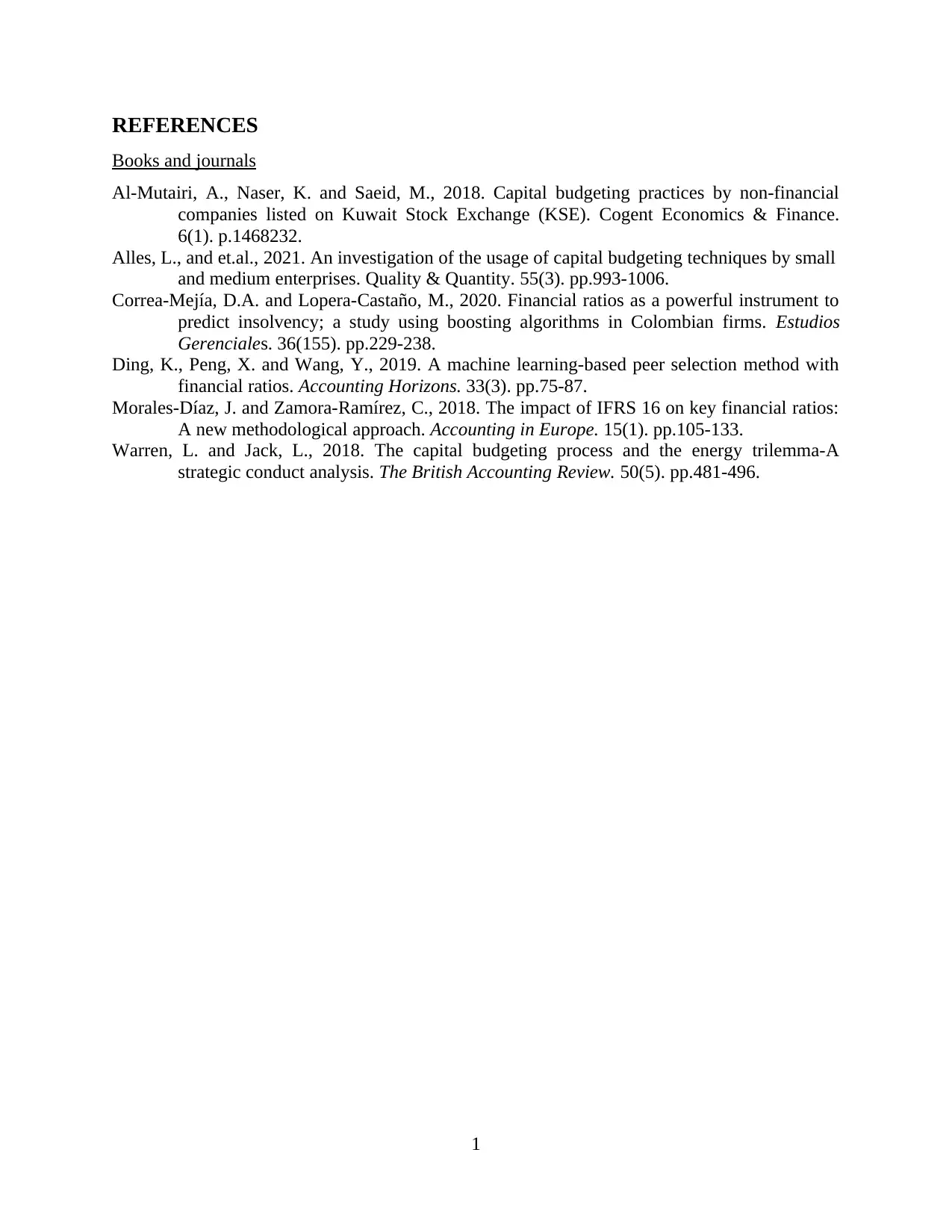
REFERENCES
Books and journals
Al-Mutairi, A., Naser, K. and Saeid, M., 2018. Capital budgeting practices by non-financial
companies listed on Kuwait Stock Exchange (KSE). Cogent Economics & Finance.
6(1). p.1468232.
Alles, L., and et.al., 2021. An investigation of the usage of capital budgeting techniques by small
and medium enterprises. Quality & Quantity. 55(3). pp.993-1006.
Correa-Mejía, D.A. and Lopera-Castaño, M., 2020. Financial ratios as a powerful instrument to
predict insolvency; a study using boosting algorithms in Colombian firms. Estudios
Gerenciales. 36(155). pp.229-238.
Ding, K., Peng, X. and Wang, Y., 2019. A machine learning-based peer selection method with
financial ratios. Accounting Horizons. 33(3). pp.75-87.
Morales-Díaz, J. and Zamora-Ramírez, C., 2018. The impact of IFRS 16 on key financial ratios:
A new methodological approach. Accounting in Europe. 15(1). pp.105-133.
Warren, L. and Jack, L., 2018. The capital budgeting process and the energy trilemma-A
strategic conduct analysis. The British Accounting Review. 50(5). pp.481-496.
1
Books and journals
Al-Mutairi, A., Naser, K. and Saeid, M., 2018. Capital budgeting practices by non-financial
companies listed on Kuwait Stock Exchange (KSE). Cogent Economics & Finance.
6(1). p.1468232.
Alles, L., and et.al., 2021. An investigation of the usage of capital budgeting techniques by small
and medium enterprises. Quality & Quantity. 55(3). pp.993-1006.
Correa-Mejía, D.A. and Lopera-Castaño, M., 2020. Financial ratios as a powerful instrument to
predict insolvency; a study using boosting algorithms in Colombian firms. Estudios
Gerenciales. 36(155). pp.229-238.
Ding, K., Peng, X. and Wang, Y., 2019. A machine learning-based peer selection method with
financial ratios. Accounting Horizons. 33(3). pp.75-87.
Morales-Díaz, J. and Zamora-Ramírez, C., 2018. The impact of IFRS 16 on key financial ratios:
A new methodological approach. Accounting in Europe. 15(1). pp.105-133.
Warren, L. and Jack, L., 2018. The capital budgeting process and the energy trilemma-A
strategic conduct analysis. The British Accounting Review. 50(5). pp.481-496.
1
⊘ This is a preview!⊘
Do you want full access?
Subscribe today to unlock all pages.

Trusted by 1+ million students worldwide
1 out of 12
Related Documents
Your All-in-One AI-Powered Toolkit for Academic Success.
+13062052269
info@desklib.com
Available 24*7 on WhatsApp / Email
![[object Object]](/_next/static/media/star-bottom.7253800d.svg)
Unlock your academic potential
Copyright © 2020–2025 A2Z Services. All Rights Reserved. Developed and managed by ZUCOL.


